warning light Citroen GRAND C4 PICASSO RHD 2017 2.G User Guide
[x] Cancel search | Manufacturer: CITROEN, Model Year: 2017, Model line: GRAND C4 PICASSO RHD, Model: Citroen GRAND C4 PICASSO RHD 2017 2.GPages: 523, PDF Size: 11.96 MB
Page 43 of 523
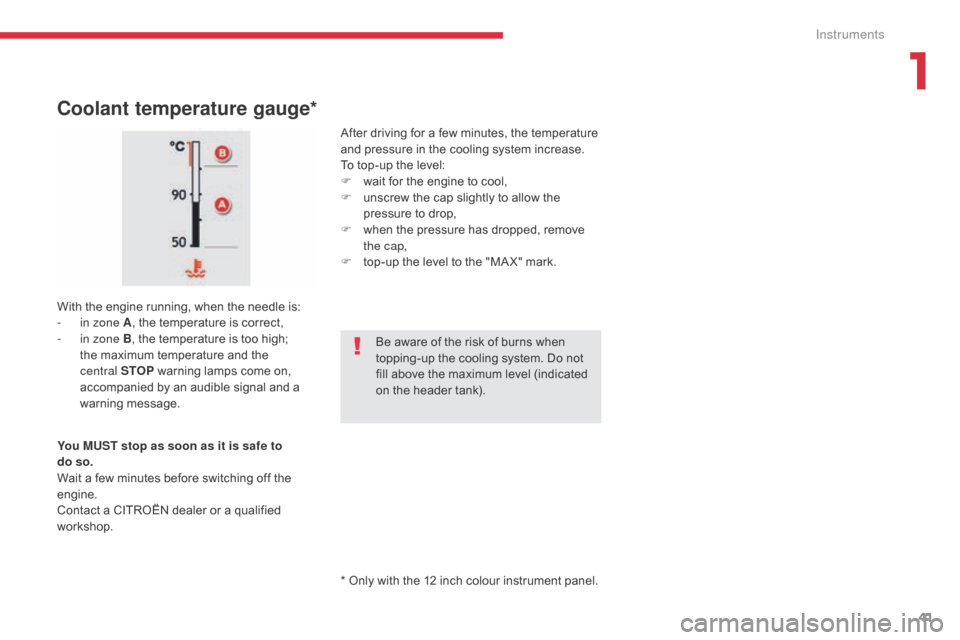
41
* Only with the 12 inch colour instrument panel.
Coolant temperature gauge*
After driving for a few minutes, the temperature
and pressure in the cooling system increase.
To top-up the level:
F
w
ait for the engine to cool,
F
u
nscrew the cap slightly to allow the
pressure to drop,
F
w
hen the pressure has dropped, remove
the cap,
F
t
op-up the level to the "MA X" mark.
With the engine running, when the needle is:
-
i
n zone A , the temperature is correct,
-
i
n zone B, the temperature is too high;
the maximum temperature and the
central STOP warning lamps come on,
accompanied by an audible signal and a
warning message. Be aware of the risk of burns when
topping-up the cooling system. Do not
fill above the maximum level (indicated
on the header tank).
You MUST stop as soon as it is safe to
do
so.
Wait a few minutes before switching off the
engine.
Contact a CITROËN dealer or a qualified
workshop.
1
Instruments
Page 50 of 523
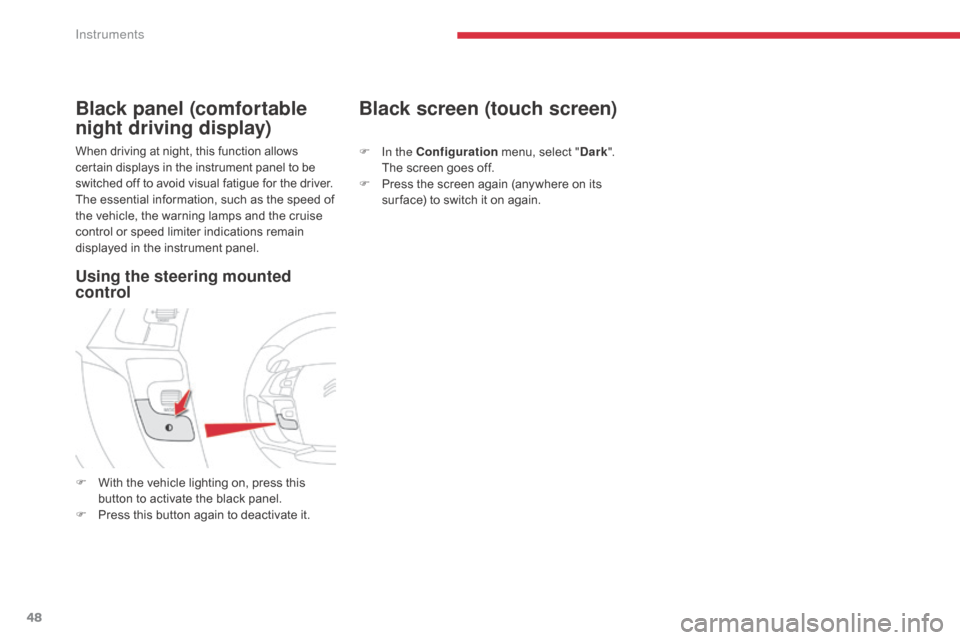
48
When driving at night, this function allows
certain displays in the instrument panel to be
switched off to avoid visual fatigue for the driver.
The essential information, such as the speed of
the vehicle, the warning lamps and the cruise
control or speed limiter indications remain
displayed in the instrument panel.
F
W
ith the vehicle lighting on, press this
button to activate the black panel.
F
P
ress this button again to deactivate it.
Black screen (touch screen)
Black panel (comfortable
night driving display)
F In the Configuration menu, select "Dark".
The screen goes off.
F
P
ress the screen again (anywhere on its
sur face) to switch it on again.
Using the steering mounted
control
Instruments
Page 125 of 523
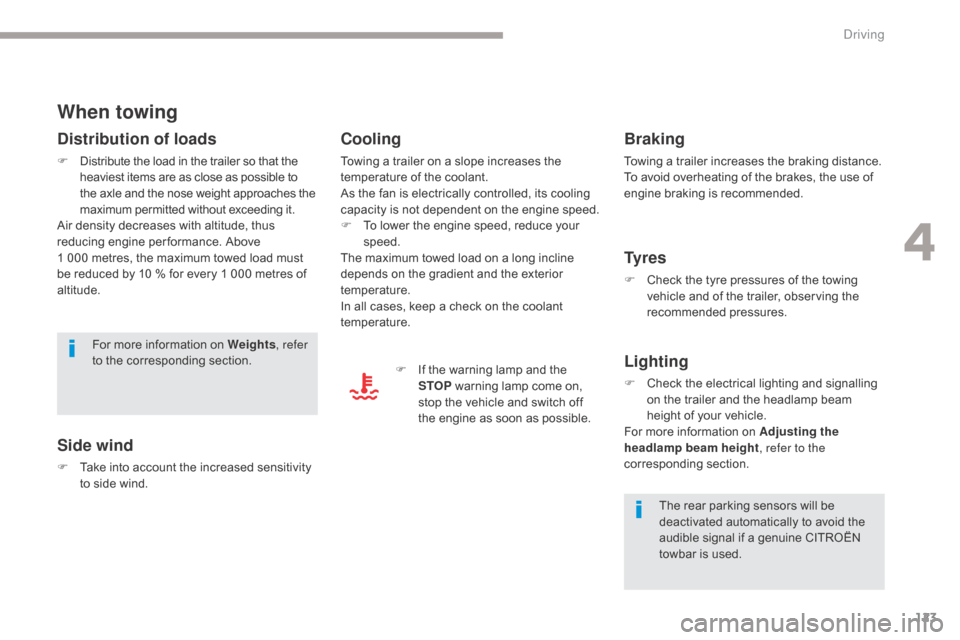
123
When towing
Distribution of loads
F Distribute the load in the trailer so that the heaviest items are as close as possible to
the axle and the nose weight approaches the
maximum permitted without exceeding it.
Air density decreases with altitude, thus
reducing engine per formance. Above
1
000 metres, the maximum towed load must
be reduced by 10
% for every 1 000 metres of
altitude.
Side wind
F Take into account the increased sensitivity to side wind.For more information on Weights
, refer
to the corresponding section.
The rear parking sensors will be
deactivated automatically to avoid the
audible signal if a genuine CITROËN
towbar is used.
Cooling
Towing a trailer on a slope increases the
temperature of the coolant.
As the fan is electrically controlled, its cooling
capacity is not dependent on the engine speed.
F
T
o lower the engine speed, reduce your
speed.
The maximum towed load on a long incline
depends on the gradient and the exterior
temperature.
In all cases, keep a check on the coolant
temperature.
F
I
f the warning lamp and the
STOP warning lamp come on,
stop the vehicle and switch off
the engine as soon as possible.
Braking
Towing a trailer increases the braking distance.
To avoid overheating of the brakes, the use of
engine braking is recommended.
Ty r e s
F Check the tyre pressures of the towing vehicle and of the trailer, observing the
recommended pressures.
Lighting
F Check the electrical lighting and signalling on the trailer and the headlamp beam
height of your vehicle.
For more information on Adjusting the
headlamp beam height , refer to the
corresponding section.
4
Driving
Page 126 of 523
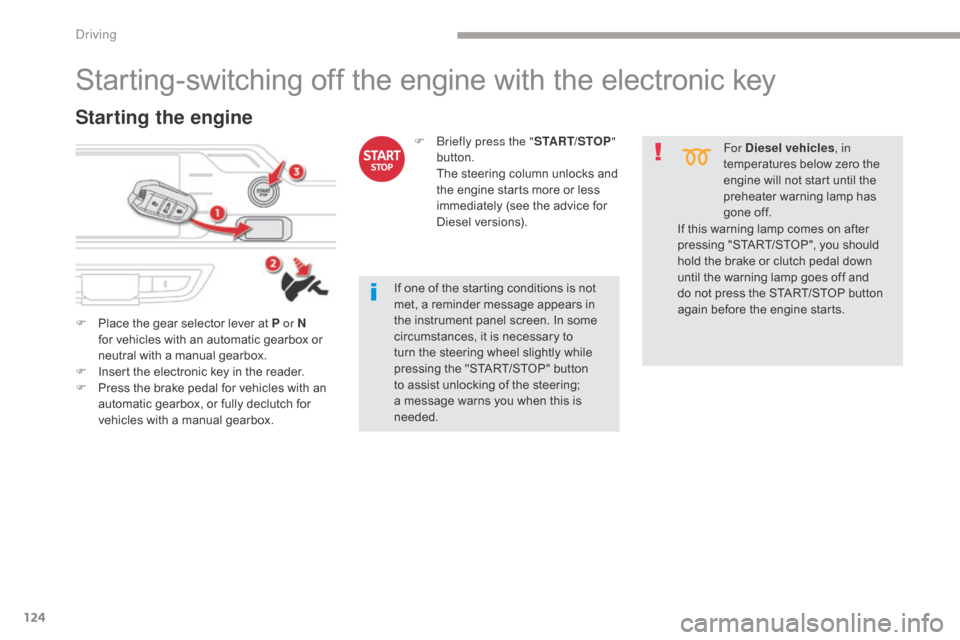
124
Starting-switching off the engine with the electronic key
F Place the gear selector lever at P or N for vehicles with an automatic gearbox or
neutral with a manual gearbox.
F
I
nsert the electronic key in the reader.
F
P
ress the brake pedal for vehicles with an
automatic gearbox, or fully declutch for
vehicles with a manual gearbox.
Starting the engine
For Diesel vehicles , in
temperatures below zero the
engine will not start until the
preheater warning lamp has
gone off.
If one of the starting conditions is not
met, a reminder message appears in
the instrument panel screen. In some
circumstances, it is necessary to
turn the steering wheel slightly while
pressing the "START/STOP" button
to assist unlocking of the steering;
a message warns you when this is
needed. F
B
riefly press the "
START/STOP"
button.
T
he steering column unlocks and
the engine starts more or less
immediately (see the advice for
Diesel versions). If this warning lamp comes on after
pressing "START/STOP", you should
hold the brake or clutch pedal down
until the warning lamp goes off and
do not press the START/STOP button
again before the engine starts.
Driving
Page 128 of 523
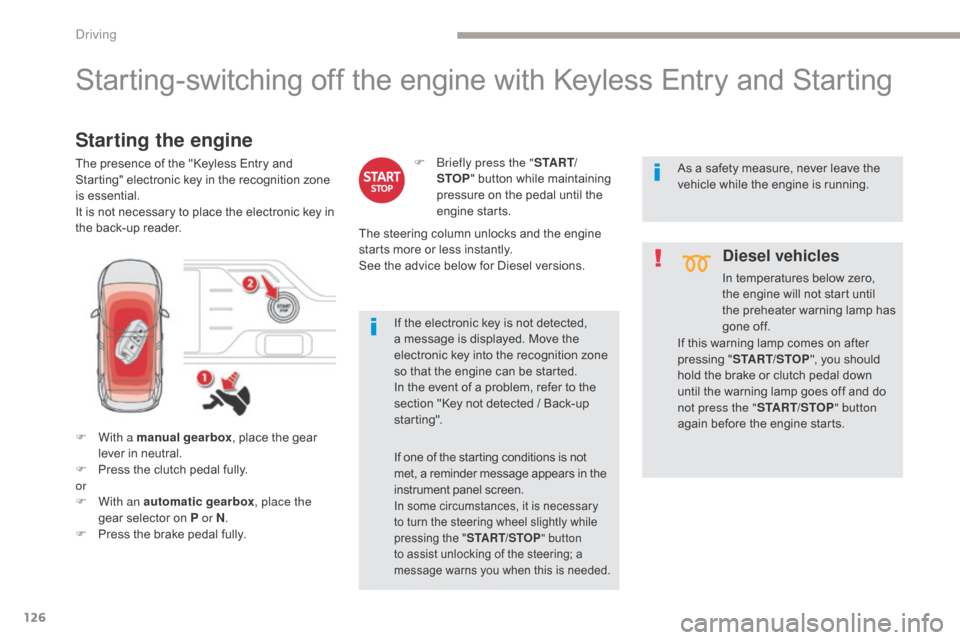
126
Starting-switching off the engine with Keyless Entry and Starting
F With a manual gearbox, place the gear
lever in neutral.
F
P
ress the clutch pedal fully.
or
F
W
ith an automatic gearbox , place the
gear selector on P or N .
F
P
ress the brake pedal fully.
Diesel vehicles
In temperatures below zero,
the engine will not start until
the preheater warning lamp has
gone off.
Starting the engine
The presence of the "Keyless Entry and
Starting" electronic key in the recognition zone
is essential.
It is not necessary to place the electronic key in
the back-up reader. If the electronic key is not detected,
a message is displayed. Move the
electronic key into the recognition zone
so that the engine can be started.
In the event of a problem, refer to the
section "Key not detected / Back-up
starting".F
B riefly press the "
S TA R T/
STOP " button while maintaining
pressure on the pedal until the
engine starts.
If one of the starting conditions is not
met, a reminder message appears in the
instrument panel screen.
In some circumstances, it is necessary
to turn the steering wheel slightly while
pressing the " START/STOP " button
to assist unlocking of the steering; a
message warns you when this is needed.
As a safety measure, never leave the
vehicle while the engine is running.
The steering column unlocks and the engine
starts more or less instantly.
See the advice below for Diesel versions.
If this warning lamp comes on after
pressing "START/STOP ", you should
hold the brake or clutch pedal down
until the warning lamp goes off and do
not press the " START/STOP" button
again before the engine starts.
Driving
Page 179 of 523
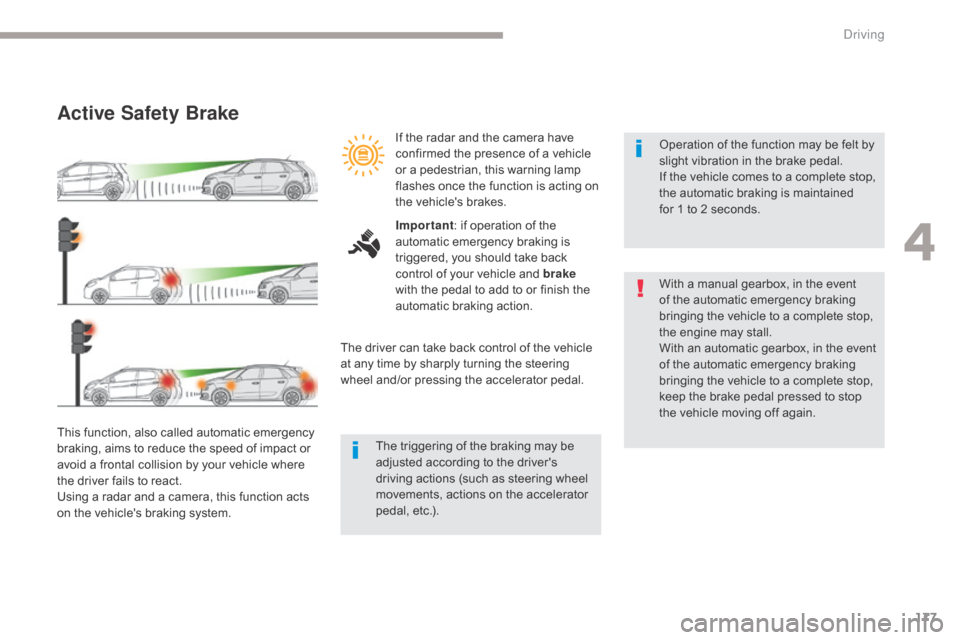
177
Active Safety Brake
This function, also called automatic emergency
braking, aims to reduce the speed of impact or
avoid a frontal collision by your vehicle where
the driver fails to react.
Using a radar and a camera, this function acts
on the vehicle's braking system.Operation of the function may be felt by
slight vibration in the brake pedal.
If the vehicle comes to a complete stop,
the automatic braking is maintained
for
1 to 2 seconds.
With a manual gearbox, in the event
of the automatic emergency braking
bringing the vehicle to a complete stop,
the engine may stall.
With an automatic gearbox, in the event
of the automatic emergency braking
bringing the vehicle to a complete stop,
keep the brake pedal pressed to stop
the vehicle moving off again.
If the radar and the camera have
confirmed the presence of a vehicle
or a pedestrian, this warning lamp
flashes once the function is acting on
the vehicle's brakes.
Important
: if operation of the
automatic emergency braking is
triggered, you should take back
control of your vehicle and brake
with the pedal to add to or finish the
automatic braking action.
The driver can take back control of the vehicle
at any time by sharply turning the steering
wheel and/or pressing the accelerator pedal.
The triggering of the braking may be
adjusted according to the driver's
driving actions (such as steering wheel
movements, actions on the accelerator
pedal, etc.).
4
Driving
Page 181 of 523
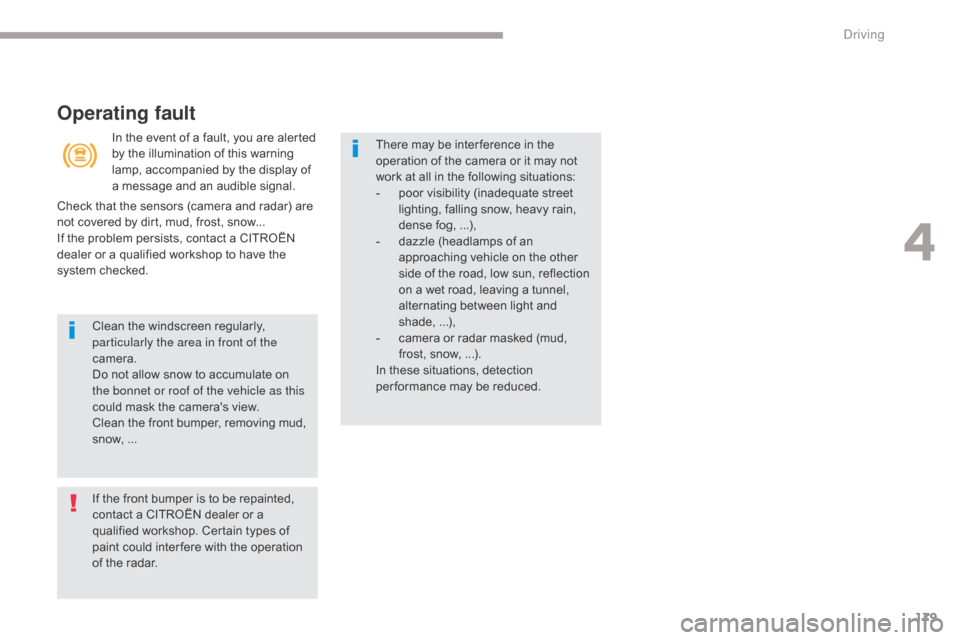
179
Operating fault
In the event of a fault, you are alerted
by the illumination of this warning
lamp, accompanied by the display of
a message and an audible signal.
If the front bumper is to be repainted,
contact a CITROËN dealer or a
qualified workshop. Certain types of
paint could inter fere with the operation
of the radar. Clean the windscreen regularly,
particularly the area in front of the
camera.
Do not allow snow to accumulate on
the bonnet or roof of the vehicle as this
could mask the camera's view.
Clean the front bumper, removing mud,
snow, ... There may be inter ference in the
operation of the camera or it may not
work at all in the following situations:
-
p
oor visibility (inadequate street
lighting, falling snow, heavy rain,
dense fog, ...),
-
d
azzle (headlamps of an
approaching vehicle on the other
side of the road, low sun, reflection
on a wet road, leaving a tunnel,
alternating between light and
shade, ...),
-
c
amera or radar masked (mud,
frost, snow, ...).
In these situations, detection
per formance may be reduced.
Check that the sensors (camera and radar) are
not covered by dirt, mud, frost, snow...
If the problem persists, contact a CITROËN
dealer or a qualified workshop to have the
system checked.
4
Driving
Page 185 of 523
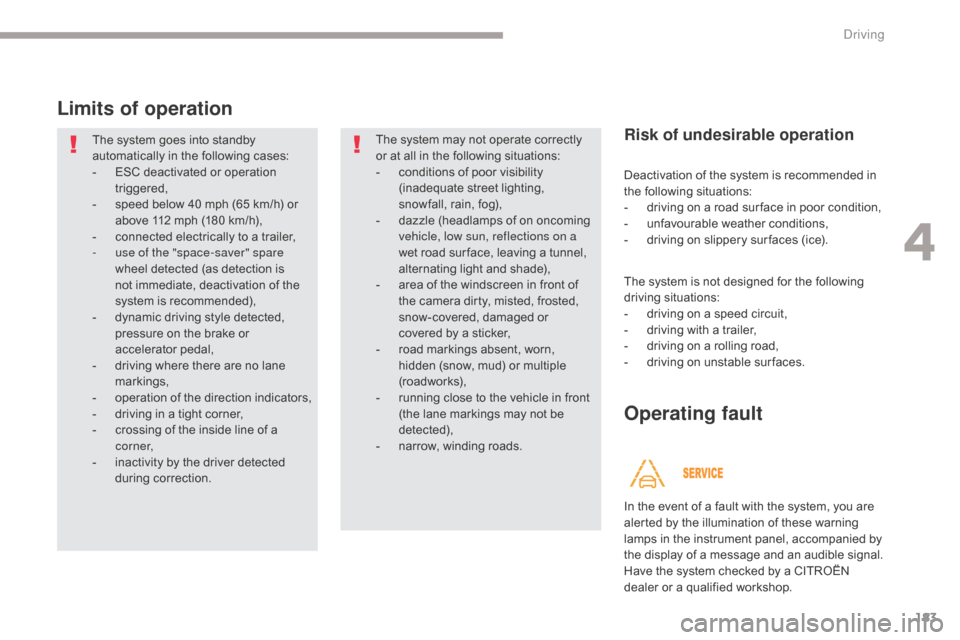
183
Limits of operation
The system goes into standby
automatically in the following cases:
-
ES
C deactivated or operation
triggered,
-
s
peed below 40 mph (65 km/h) or
above 112 mph (180 km/h),
-
c
onnected electrically to a trailer,
-
u
se of the "space-saver" spare
wheel detected (as detection is
not immediate, deactivation of the
system is recommended),
-
d
ynamic driving style detected,
pressure on the brake or
accelerator pedal,
-
d
riving where there are no lane
markings,
-
ope
ration of the direction indicators,
-
d
riving in a tight corner,
-
c
rossing of the inside line of a
c o r n e r,
-
i
nactivity by the driver detected
during correction. The system may not operate correctly
or at all in the following situations:
-
c
onditions of poor visibility
(inadequate street lighting,
snowfall, rain, fog),
-
d
azzle (headlamps of on oncoming
vehicle, low sun, reflections on a
wet road sur face, leaving a tunnel,
alternating light and shade),
-
a
rea of the windscreen in front of
the camera dirty, misted, frosted,
snow-covered, damaged or
covered by a sticker,
-
r
oad markings absent, worn,
hidden (snow, mud) or multiple
(roadworks),
-
r
unning close to the vehicle in front
(the lane markings may not be
detected),
-
n
arrow, winding roads.Risk of undesirable operation
Deactivation of the system is recommended in
the following situations:
-
d
riving on a road sur face in poor condition,
-
u
nfavourable weather conditions,
-
d
riving on slippery sur faces (ice).
The system is not designed for the following
driving situations:
-
d
riving on a speed circuit,
-
d
riving with a trailer,
-
d
riving on a rolling road,
-
d
riving on unstable sur faces.
In the event of a fault with the system, you are
alerted by the illumination of these warning
lamps in the instrument panel, accompanied by
the display of a message and an audible signal.
Have the system checked by a CITROËN
dealer or a qualified workshop.
Operating fault
4
Driving
Page 187 of 523
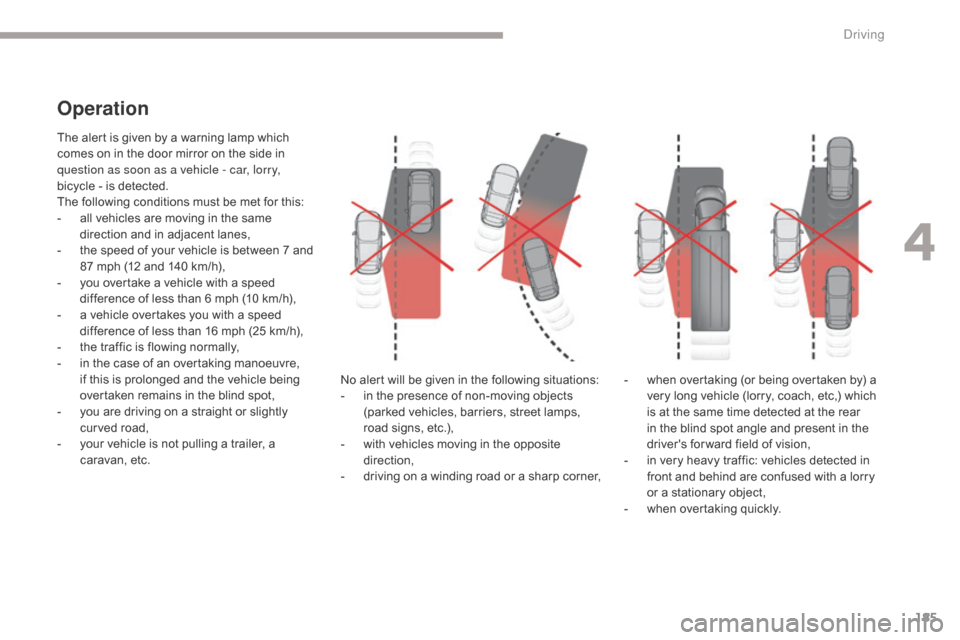
185
The alert is given by a warning lamp which
comes on in the door mirror on the side in
question as soon as a vehicle - car, lorry,
bicycle - is detected.
The following conditions must be met for this:
-
a
ll vehicles are moving in the same
direction and in adjacent lanes,
-
t
he speed of your vehicle is between 7 and
87 mph (12 and 140 km/h),
-
y
ou overtake a vehicle with a speed
difference of less than 6 mph (10 km/h),
-
a v
ehicle overtakes you with a speed
difference of less than 16 mph (25 km/h),
-
t
he traffic is flowing normally,
-
i
n the case of an overtaking manoeuvre,
if this is prolonged and the vehicle being
overtaken remains in the blind spot,
-
y
ou are driving on a straight or slightly
curved road,
-
y
our vehicle is not pulling a trailer, a
caravan, etc. No alert will be given in the following situations:
-
i
n the presence of non-moving objects
(parked vehicles, barriers, street lamps,
road signs, etc.),
-
w
ith vehicles moving in the opposite
direction,
-
d
riving on a winding road or a sharp corner,
Operation
- when overtaking (or being overtaken by) a very long vehicle (lorry, coach, etc,) which
is at the same time detected at the rear
in the blind spot angle and present in the
driver's for ward field of vision,
-
i
n very heavy traffic: vehicles detected in
front and behind are confused with a lorry
or a stationary object,
-
w
hen overtaking quickly.
4
Driving
Page 190 of 523
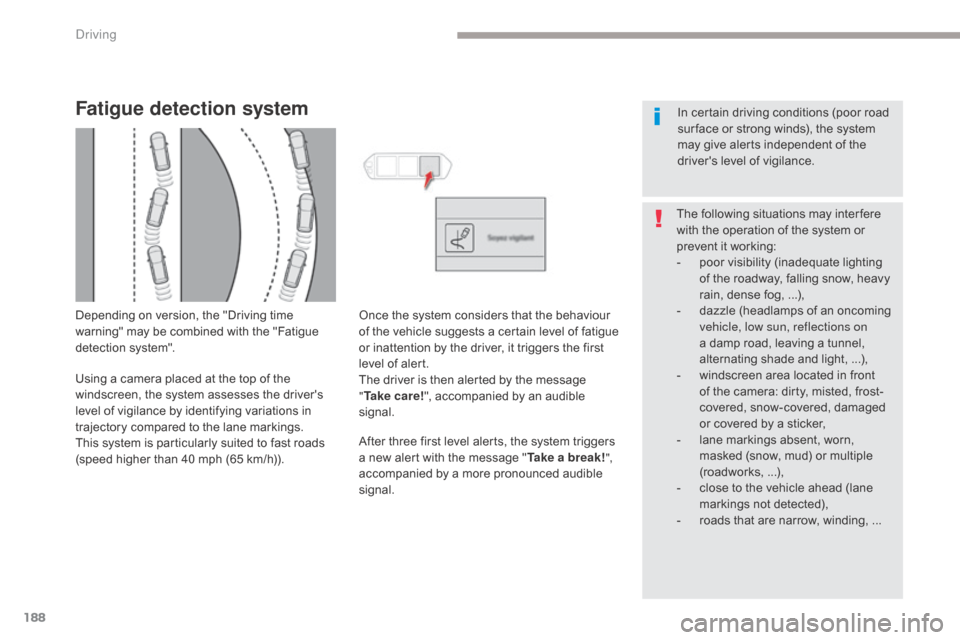
188
Fatigue detection system
Depending on version, the "Driving time
warning" may be combined with the "Fatigue
detection system".
Using a camera placed at the top of the
windscreen, the system assesses the driver's
level of vigilance by identifying variations in
trajectory compared to the lane markings.
This system is particularly suited to fast roads
(speed higher than 40 mph (65 km/h)).Once the system considers that the behaviour
of the vehicle suggests a certain level of fatigue
or inattention by the driver, it triggers the first
level of alert.
The driver is then alerted by the message
"
Ta k e c a r e ! ", accompanied by an audible
signal.
After three first level alerts, the system triggers
a new alert with the message " Take a break!",
accompanied by a more pronounced audible
signal. In certain driving conditions (poor road
sur face or strong winds), the system
may give alerts independent of the
driver's level of vigilance.
The following situations may inter fere
with the operation of the system or
prevent it working:
-
p
oor visibility (inadequate lighting
of the roadway, falling snow, heavy
rain, dense fog, ...),
- d azzle (headlamps of an oncoming
vehicle, low sun, reflections on
a damp road, leaving a tunnel,
alternating shade and light, ...),
-
w
indscreen area located in front
of the camera: dirty, misted, frost-
covered, snow-covered, damaged
or covered by a sticker,
-
l
ane markings absent, worn,
masked (snow, mud) or multiple
(roadworks, ...),
-
c
lose to the vehicle ahead (lane
markings not detected),
-
r
oads that are narrow, winding, ...
Driving